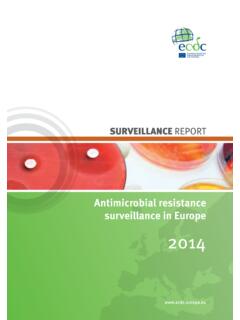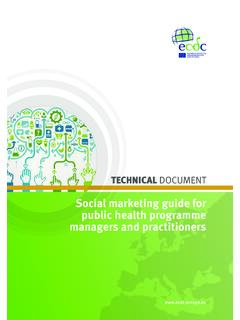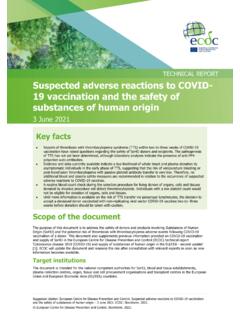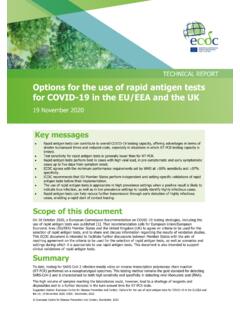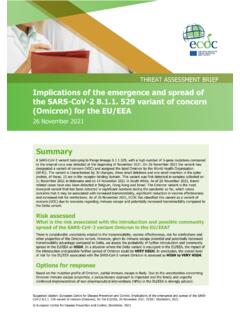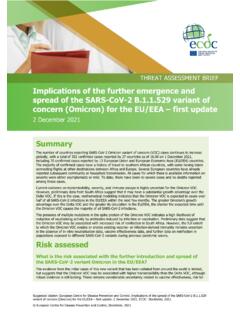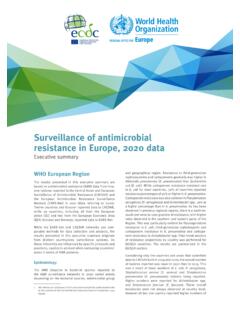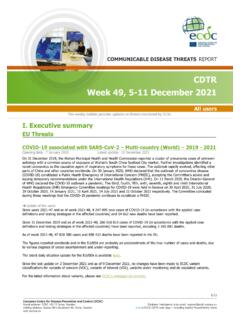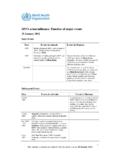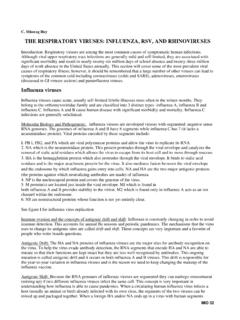Transcription of CDTR Week 1, 2-8 January 2022
1 EU ThreatsI. Executive summaryAll usersWeek 1, 2-8 January 2022 CDTRREPORTCOMMUNICABLE DISEASE THREATSThis weekly bulletin provides updates on threats monitored by Centre for Disease Prevention and Control (ECDC)Postal address: ECDC 169 73 Solna, SwedenVisiting address: Gustav III:s Boulevard 40, Solna, Intelligence duty email: to ECDC CDTR web page including related PowerPoint slidesCOVID-19 associated with SARS-CoV-2 Multi-country (World) Opening date: 7 January 2020 Latest update: 7 January 2022On 31 December 2019, the Wuhan Municipal Health and Health Commission reported a cluster of pneumonia cases of unknown aetiology with a common source of exposure at Wuhan's South China Seafood City market. Further investigations identified a novel coronavirus as the causative agent of respiratory symptoms for these cases.
2 The outbreak rapidly evolved, affecting other parts of China and other countries worldwide. On 30 January 2020, WHO declared that the outbreak of coronavirus disease (COVID-19) constituted a Public Health Emergency of International Concern (PHEIC), accepting the Committee's advice and issuing temporary recommendations under the International Health Regulations (IHR). On 11 March 2020, the Director-General of WHO declared the COVID-19 outbreak a pandemic. The third, fourth, fifth, sixth, seventh, eighth and ninth International Health Regulations (IHR) Emergency Committee meetings for COVID-19 were held in Geneva on 30 April 2020, 31 July 2020, 29 October 2020, 14 January 2021, 15 April 2021, 14 July 2021 and 22 October 2021, respectively. The Committee concluded during these meetings that the COVID-19 pandemic continues to constitute a PHEIC.
3 Update of the weekSince week 2021-50 and as of week 2021-52, 15 679 622 new cases of COVID-19 (in accordance with the applied case definitions and testing strategies in the affected countries) and 87 175 new deaths have been 31 December 2019 and as of week 2021-52, 290 613 933 cases of COVID-19 (in accordance with the applied case definitions and testing strategies in the affected countries) have been reported, including 5 450 958 of week 2021-52, 56 969 698 cases and 908 731 deaths have been reported in the figures reported worldwide and in the EU/EEA are probably an underestimate of the true number of cases and deaths, due to various degrees of under-ascertainment and latest daily situation update for the EU/EEA is available the last update on 22 December 2021 and as of 5 January 2022, no changes have been made to ECDC variant classifications for variants of concern (VOC), variants of interest (VOI), variants under monitoring and de-escalated the latest information about variants, please see ECDC's webpage on variant of concern (Omicron) - Multi country (World)
4 - 2021-2022On 26 November 2021, ECDC classified a SARS-CoV-2 variant belonging to Pango lineage as a variant of concern (VOC) due to concerns regarding immune escape and potentially increased transmissibility compared to the Delta VOC. WHO also classified the variant as a VOC and assigned it the label Omicron. The number of countries reporting cases with the SARS-CoV-2 Omicron VOC continues to increase date:3 December 2021 Latest update: 7 January 2022 Update of the weekAs of 7 January 2022, a steep increase in COVID-19 cases over the past two weeks has been observed in several EU/EEA countries. For a general overview of the epidemiological COVID-19 situation in the EU/EEA, please see the ECDC Country Overview Report. At the end of week 52, the overall epidemiological situation in the EU/EEA was characterised by a high overall case notification rate which has increased rapidly in the past two weeks.
5 High and increasing case notification rates or an epidemiological situation of high or very high concern were observed in all but two EU/EEA Member States. This situation is largely driven by the continued circulation of the Delta variant and rapidly increasing spread of the Omicron variant in many summary below aims to give an overview of the extent to which Omicron is prevalent in EU/EEA countries. The data are collected from TESSy, EU/EEA Member States' national and/or regional websites, and media reports quoting health authorities. As a result, the data presentation and completeness might be different depending on the data sources and availability on countries websites. Until further notice, ECDC will provide specific updates on the Omicron VOC weekly for EU/EEA.
6 Previous updates on reported cases are available on ECDC's dedicated Centre for Disease Prevention and Control (ECDC)Postal address: ECDC 169 73 Solna, SwedenVisiting address: Gustav III:s Boulevard 40, Solna, Intelligence duty email: to ECDC CDTR web page including related PowerPoint slidesThe CDTR contains information that could be considered sensitive or is still under verification. Its distribution is restricted to intended users DISEASE THREATSREPORTWeek 1, 2-8 January 2022On 6 January 2022, the United Kingdom Health Security Agency (UKHSA) notified of a confirmed case of avian influenza A type H5 in a person in the South West of ! influenza A (type H5) United Kingdom, England Opening date: 7 January 2022 Latest update: 7 January 2022 Non EU ThreatsOpening date: 3 December 2021 Reported influenza activity in Europe is increasing.
7 A detailed report on the current situation is available in this weekly threats Multi-country Monitoring 2021/2022 seasonOpening date: 15 October 2021 Latest update: 7 January 2022 Update of the weekWeek 52, 2021 (27 December 2021 - 2 January 2022)Reported influenza activity in Europe continues to increase:- Albania, Israel, North Macedonia, Norway, the Russian Federation, and Sweden reported widespread influenza activity and/ormedium influenza 23% of all sentinel primary care specimens from patients presenting with ILI or ARI symptoms tested positive for influenzavirus in week 52/2021, with a predominance of A(H3) Six countries reported seasonal influenza activity above the 10% positivity threshold in sentinel primary care: Armenia (78%),Israel (68%), Sweden (36%), France (33%) the Republic of Moldova (24%), and Albania (18%).
8 - Hospitalised cases with confirmed influenza virus infection were reported from intensive care units (29 type A viruses and 1type B) and SARI surveillance (18 type A viruses ).- Both influenza type A and type B viruses were detected with A(H3) viruses being dominant across all monitoring influenza viruses that cross the animal-human divide to infect people are considered novel to humans and have the potential to become pandemic threats. highly pathogenic avian influenza viruses A(H5) of Asian origin are extremely infectious for several bird species, including poultry. In 2014, a novel avian influenza A(H5N6) reassortant causing a human infection was detected in China. To date, only sporadic human cases of avian influenza A(H5N6) virus infection have been reported, mainly from A(H5N6) Multi-country Monitoring human casesOpening date: 17 January 2018 Latest update: 7 January 2022 Update of the weekAs of 20 December2021 and since the previous monthly report published in the CDTR on 19 November 2021, six new cases, including one death, of human infection with avian influenza A(H5N6) virus have been reported from four provinces in China (Guangdong, Guangxi, Hunan, and Sichuan).
9 The cases developed symptoms in November and December 2021; five cases were adults and one child; five were hospitalised and one had mild symptoms. No human-to-human transmission was influenza viruses that infect people are considered novel to humans and have the potential to become pandemic A(H9N2) - Multi-country (World) - Monitoring human casesOpening date: 30 January 2019 Latest update: 7 January 2022 Update of the weekAs of 20 December 2021, and since the previous monthly report published in CDTR on 19 November 2021, one new case of human infection with avian influenza A(H9N2) was reported from China. No further cases were detected among contacts of this patient. Overall, 95 cases have been reported globally since influenza viruses that infect people are considered novel to humans and have the potential to become pandemic threats.
10 Sporadic cases of swine origin influenza A(H1N2) virus variant infections in humans are reported from EU countries, Canada, and the United States. Human cases with swine influenza A(H1N2) variant virus Multi-country Opening date: 1 June 2021 Latest update: 7 January 2022 Update of the weekFrom 17 November 2021 to December, one new case with swine influenza A(H1N2) variant virus was reported in an adult from Manitoba, Canada. The case had exposure to countries in Africa and Asia have reported cholera outbreaks in 2021. Major ongoing outbreaks are being reported from Bangladesh, Nigeria, and Niger. Haiti reported its last laboratory-confirmed case in February Multi-country (World) Monitoring global outbreaksOpening date: 20 April 2006 Latest update: 7 January 20223/25 European Centre for Disease Prevention and Control (ECDC)Postal address: ECDC 169 73 Solna, SwedenVisiting address: Gustav III:s Boulevard 40, Solna, Intelligence duty email: to ECDC CDTR web page including related PowerPoint slidesThe CDTR contains information that could be considered sensitive or is still under verification.
